What is Carpet Tile? We Have the Answers
Carpet tile is a great choice for your home or commercial space. Out of all the carpet options out there, carpet tile is the easiest to install, the easiest to replace, and it lets you express your creativity the most. But how do you pick the perfect tile?
If you’re in search of the ultimate guide to carpet tile, you’re in the right place. We’ve got it right here for you!
In this guide, you’ll find everything you need to know about this DIY-friendly flooring, including the pros and cons, installation methods, and the many ways you can use carpet tiles.
If you’re in search of the ultimate guide to carpet tile, you’re in the right place. We’ve got it right here for you!
In this guide, you’ll find everything you need to know about this DIY-friendly flooring, including the pros and cons, installation methods, and the many ways you can use carpet tiles.
What are Carpet Tiles?
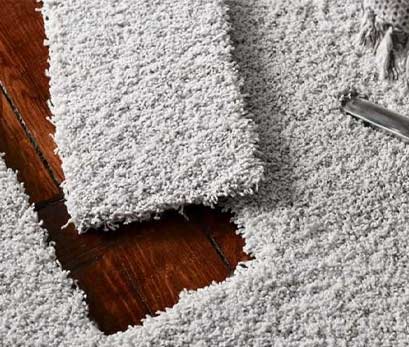
Carpet tiles are exactly as the name suggests – carpet that comes in square tile form instead of broadloom rolls.
Also known as carpet squares, these tiles have been popular for commercial use for many years, and now they’re a growing trend in homes as well. You can find carpet tiles just about anywhere – in basements, bedrooms, gyms, movie theaters, and even garages.
Carpet tile often has backing and padding attached, so you don’t need to invest in any extra products to install. Just simply peel and stick, glue, tape, or lock your carpet tiles down and go.
It’s so easy, you can completely tile a room in carpet in only a few hours.
Also known as carpet squares, these tiles have been popular for commercial use for many years, and now they’re a growing trend in homes as well. You can find carpet tiles just about anywhere – in basements, bedrooms, gyms, movie theaters, and even garages.
Carpet tile often has backing and padding attached, so you don’t need to invest in any extra products to install. Just simply peel and stick, glue, tape, or lock your carpet tiles down and go.
It’s so easy, you can completely tile a room in carpet in only a few hours.
Carpet Tile vs. Carpet Planks
As carpet tiles have grown in popularity, the standard shape has always been a square. Carpet squares are great for creating checkered patterns, and they make it easy to calculate exactly how much flooring you need for a room. Carpet tiles will never truly go out of style, but now you have another option. And who doesn’t love options?
Recently, carpet planks have been making a big impression in the world of flooring. They come with all the same benefits of standard tiles, but the rectangular plank shape mimics the huge popularity of planks in other flooring options, like tile and wood. Carpet planks open the door to new pattern possibilities, like Herringbone and even Chevron looks if you’re feeling crafty.
Recently, carpet planks have been making a big impression in the world of flooring. They come with all the same benefits of standard tiles, but the rectangular plank shape mimics the huge popularity of planks in other flooring options, like tile and wood. Carpet planks open the door to new pattern possibilities, like Herringbone and even Chevron looks if you’re feeling crafty.
Pros and Cons of Carpet Tile
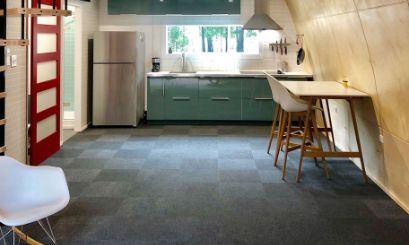
At this point, maybe you’re wondering why you would choose carpet tile over broadloom. The fact is, carpet tile is more versatile than broadloom, and you might find it better suited for your comfy space. To get a better idea of how it performs, read up on the pros and cons.
What are the benefits of carpet tiles?
- DIY-friendly: Carpet tiles are very easy to install and can be done in a matter of hours. Since the backing and sometimes adhesive are included as part of the tile, there are no extra hidden costs. Save your money for the decorations.
- Patterns and textures: By using different colors or simply rotating the tile, you can get a custom look. So go ahead and get creative!
- Replaceable: Carpet tile is also super easy to replace if one section gets damaged or stained. Just lift out the badly damaged tile and replace it with a new one. Good as new.
- Customization: You can easily create custom area rugs for your space. No more buying the same rug as everyone else. You can be unique.
- Less wasteful: Carpet tiles produce less waste than installing broadloom carpet. That’s because tile comes in different sizes so you end up cutting less to fit the space.
What are the drawbacks of carpet tiles?
Like with every product, you should know the ins and outs of what you’re buying. Though carpet tiles are amazing, they still have their limitations.
- Thickness: Carpet tiles often lack the softness of broadloom because they aren’t as thick. However, we do offer some carpet tiles with attached padding that are plush and comfortable.
- Not as plush: Carpet tiles also are mostly found in loop piles. Because it began as a commercial trend, you’ll probably find fewer options that feature plush cut piles. Loop carpet, however, is more durable and hides dirt, wear much better.
What are Carpet Tiles Made Of?
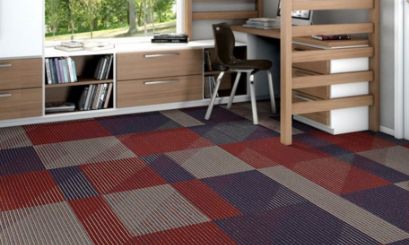
Not all carpets are the same. They can be made from a variety of fibers that will affect the feel, durability, and performance of the carpet. Here’s a breakdown of some of the most common carpet fibers.
- Nylon: This is the most popular carpet fiber. Why? Because it’s durable, static-free, and often treated with a stain-blocking technology. It stays beautiful, longer. Note: Nylon carpets are only recommended for indoor use.
- Polyester: For a more environmentally friendly option, consider Polyester. It is mostly made from recycled materials. Plus it’s slightly cheaper than nylon and almost as durable. This fiber offers the most color choices, along with extreme stain-resistance and fade-resistance. Polyester / PET is also growing in popularity. More manufacturers are using it as a low-cost commercial option that is durable.
- Polypropylene: This fiber resists staining and fading because the color runs through the fiber rather than just being dyed on the outside. Polypropylene is soft and durable, but it has a tendency to absorb oil that can make it look dingy if not maintained properly.
Carpet Tile Backing Options
Everyone pays attention to the top of the carpet tile, but the backing is important, too! It can determine the softness, durability, and even the eco-friendliness of your carpet.
You can choose from many different backings, and while they all keep the carpet tile and floor together, the differences can determine where, and how, you should use the tile.
You can choose from many different backings, and while they all keep the carpet tile and floor together, the differences can determine where, and how, you should use the tile.
- PVC: This is a durable plastic that doesn’t cost a lot to make, which in turn keeps the price of the carpet down.
- Plastic (PVC-Free): PVC-free plastic is recyclable, which means your carpet tile is more eco-friendly.
- Polyurethane cushion: The extra cushioning in this backing makes your carpet tile more comfortable.
- Rubber: A rubber backing gives you the durability of rubber and the softness of carpeting combined. Carpet tiles with this backing are great for high-traffic areas.
- Foam: Foam-backed tiles offer the comfort of foam flooring. Foam carpet tiles are popular for trade shows and other applications where anti-fatigue flooring is desired.
- Polypropylene: Providing durability and impact resistance, this tough plastic backing is often used for tiles with an interlocking peg and loop system.
How to Install Carpet Tiles
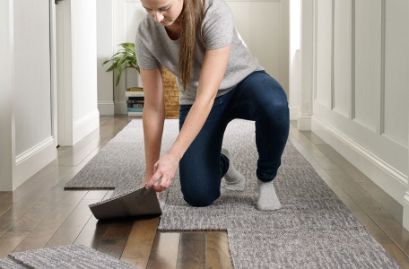
How do you install carpet tiles? The answer depends on the kind of tile you buy. There are three main installation methods: peel and stick, glue-free, and interlocking.
Before you get started, you need a few tools to install, including a T-square, a utility knife, and double-sided carpet tape. Once you have all your supplies, you should allow the carpet to acclimate to the temperature and humidity of the room you’re installing in. This could take up to a day.
When prep time is over, it’s time to install.
Before you get started, you need a few tools to install, including a T-square, a utility knife, and double-sided carpet tape. Once you have all your supplies, you should allow the carpet to acclimate to the temperature and humidity of the room you’re installing in. This could take up to a day.
When prep time is over, it’s time to install.
Note: Many carpet tiles have arrows on the back. They serve two purposes:
1. To indicate the direction that the face fiber or pile runs in. This is called the pile direction. If you place two carpet tiles side by side and orient them in different directions, the way the light hits the pile direction at different angles can make it look like the tiles are different colors. For a more visually consistent installation, install the tiles with their arrows all pointing in the same direction.
2. To indicate the default direction of a pattern on the carpet tile. This can help you install your floor in the correct layout to get the design you want. There are several layouts you can create, such as the quarter-turn, the brick pattern, or the ashlar design. Whatever you choose, the arrows on the back can help you stay on track.
1. To indicate the direction that the face fiber or pile runs in. This is called the pile direction. If you place two carpet tiles side by side and orient them in different directions, the way the light hits the pile direction at different angles can make it look like the tiles are different colors. For a more visually consistent installation, install the tiles with their arrows all pointing in the same direction.
2. To indicate the default direction of a pattern on the carpet tile. This can help you install your floor in the correct layout to get the design you want. There are several layouts you can create, such as the quarter-turn, the brick pattern, or the ashlar design. Whatever you choose, the arrows on the back can help you stay on track.
Peel and Stick Carpet Tiles
If you want easy, peel and stick tiles are the way to go. The adhesive is already applied to each tile and all you have to do is pull back the plastic sheet to expose it. Simply place the carpet on the floor, and press down to make sure it sticks. That’s all there is to it!
Some adhesives leave a residue on the subfloor but some do not. There’s an easy way to test! Place your hand on the adhesive and pull it away. If your hand is sticky after, it will leave a residue on the floor, but it’s is easily cleaned up.
Some adhesives leave a residue on the subfloor but some do not. There’s an easy way to test! Place your hand on the adhesive and pull it away. If your hand is sticky after, it will leave a residue on the floor, but it’s is easily cleaned up.
Glue-Free Carpet Tiles
There are many glue-free carpet options. To install, simply purchase double-sided carpet tape. Using this tape method, you can cover the whole floor, or create a custom-made area rug.
For a room with high-traffic, you’ll need a pressure-sensitive adhesive, or glue, to keep the tiles in place more permanently.
For a room with high-traffic, you’ll need a pressure-sensitive adhesive, or glue, to keep the tiles in place more permanently.
Interlocking Carpet Tiles
Interlocking carpet tiles can either have interlocking edges like a puzzle piece, or plastic attachments that click together and aren’t visible once installed.
Tiles that connect using interlocking edges join together as if you’re putting together a puzzle. They may come with a finished edge, or you can cut them to have a finished edge.
If the tile has a plastic backing, just click them together using the peg and loop mechanisms on the side.
Tiles that connect using interlocking edges join together as if you’re putting together a puzzle. They may come with a finished edge, or you can cut them to have a finished edge.
If the tile has a plastic backing, just click them together using the peg and loop mechanisms on the side.
How to Clean and Maintain Carpet Tiles
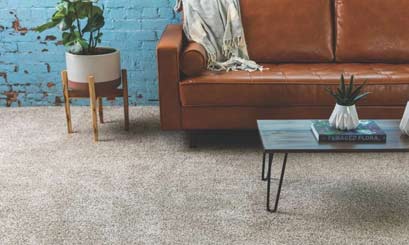
The good news is that carpet tiles are super easy to take care of. If you follow these steps, your floor should look great for years to come.
- Sweep and vacuum frequently, at least once a week, to remove dust and dirt.
- If you spill something, clean it up as soon as possible using a clean cloth and water.
- To remove stains, use a cleaning product recommended by the carpet manufacturer. If a tile is very stained, you can temporarily remove the tile to better clean it, or you can simply replace it with a brand new tile.
- Every couple of years or so, deep clean the carpet with a hot water extraction-cleaning machine (I.E. carpet cleaner). This will keep it looking its best.
Carpet Tile Uses
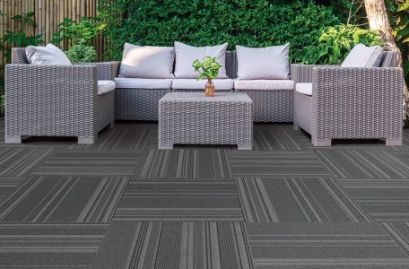
Did you know carpet tiles can be used in ways other than wall to wall carpeting? As it turns out, carpet tiles are very versatile and can be used in creative and unexpected ways. Maybe you’ve never thought about using carpet outdoors, or as gym flooring.
It’s time to think about it now. Here are just a few applications to get you inspired.
It’s time to think about it now. Here are just a few applications to get you inspired.
Area Rugs
If you’re a creative type it’s easy to make a custom made area rug that is the perfect size for your space.
To get started, just pick out the tiles in the colors or patterns you want, and fit each square together until you reach your desired size. It’s as simple as that!
To get started, just pick out the tiles in the colors or patterns you want, and fit each square together until you reach your desired size. It’s as simple as that!
Outdoor Carpet
In case you’re wondering, yes, you can have carpet outside! Indoor/outdoor carpet has special properties that keep it mold and mildew free, and also fade-free as well.
You can easily place it on a patio, in a sunroom, or on a balcony. If there’s a level floor, you can place it there.
You can easily place it on a patio, in a sunroom, or on a balcony. If there’s a level floor, you can place it there.
Gym Carpet
Interlocking carpet tiles make great gym flooring! It’s a great solution if you want something you can put together and take apart to do stretching, yoga, and light exercises.
You can also install it in a whole room for exercise equipment and light floor routines. You wouldn’t want to drop a barbell on it, but it’s great for the average exerciser.
You can also install it in a whole room for exercise equipment and light floor routines. You wouldn’t want to drop a barbell on it, but it’s great for the average exerciser.
Home Theater Carpet
If you have a home theater without carpeting, you’re missing out. Home theater carpet tiles are perfect for soaking up surround sound and preventing echoes.
The truth is, hard surfaces bounce sound around the room. Carpet absorbs bouncing sound making it loud and clear for you.
You can even use them on your home theater walls to give your sound a boost.
The truth is, hard surfaces bounce sound around the room. Carpet absorbs bouncing sound making it loud and clear for you.
You can even use them on your home theater walls to give your sound a boost.
Why Choose Carpet Tiles?
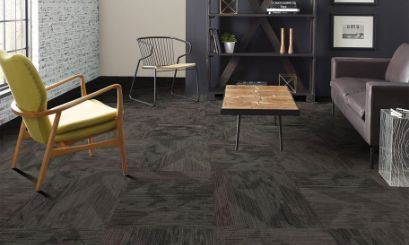
Carpet tile is the modern version of wall to wall carpet. There are so many reasons to love it, but just in case you aren’t convinced yet, here are the highlights.
- Install it yourself: There’s no need to call a professional.
- Interchangeable: You can replace a damaged tile with a brand new tile. That’s something you can’t do with traditional broadloom carpet.
- Simple: Everyone needs a little simplicity in their life and carpet tiles are simple.
- Fast: There’s something nice about upgrading your whole floor within a day.
Conclusion
Now you’re practically an expert on carpet tile, so what are you going to do with all of this new knowledge? If you’re ready to dive into the world of carpet tile, start shopping. You’re sure to find carpet for every purpose.

